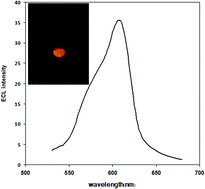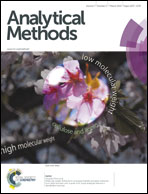Enhanced solid-state electrochemiluminescence of Ru(bpy)32+ with nano-CeO2 modified carbon paste electrode and its application in tramadol determination†
Abstract
A sensitized solid-state electrochemiluminescence (ECL) was successfully used for the determination of tramadol. The ECL signal was produced by a sensitive Ru(bpy)32+-tramadol reactions. A modified carbon paste electrode (CPE) was applied as a working electrode. Incorporation of cerium oxide nanoparticles in the carbon paste led to the fabrication of a novel ECL sensor. CeO2 showed attractive sensitizing effect on Ru(bpy)32+-tramadol electrochemiluminescence system. Under the optimal conditions for Ru(bpy)32+-tramadol system, a linear relationship between the ECL intensity and concentration of tramadol in the range of 1.0 × 10−10 to 2.5 × 10−8 mol L−1 was obtained with detection limit of 9.0 × 10−11 mol L−1 and relative standard deviation of 2.9% (S/N = 3). The method is sensitive, selective, and simple and has been successfully applied for the determination of tramadol in human serum, urine and pharmaceutical formulation.


 Please wait while we load your content...
Please wait while we load your content...